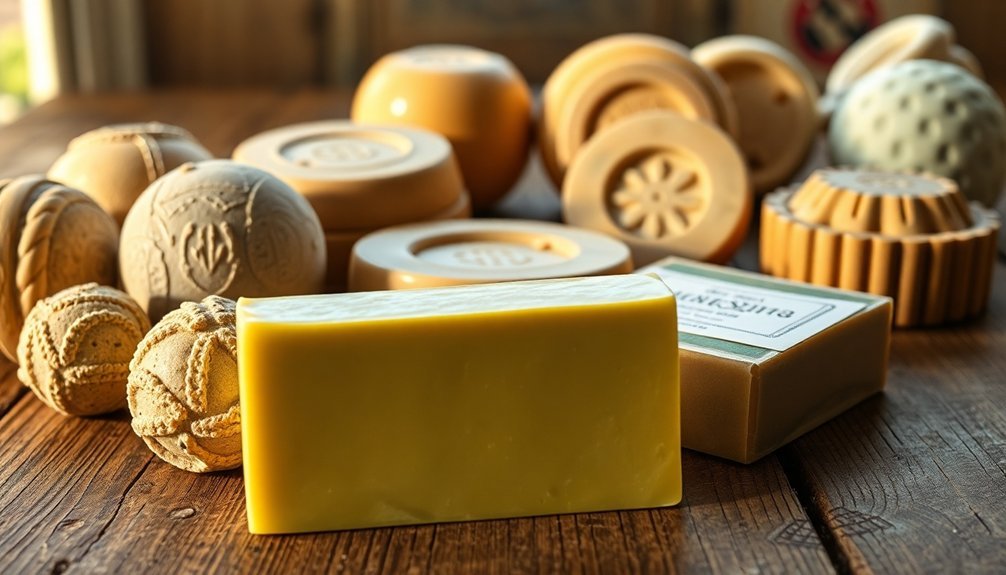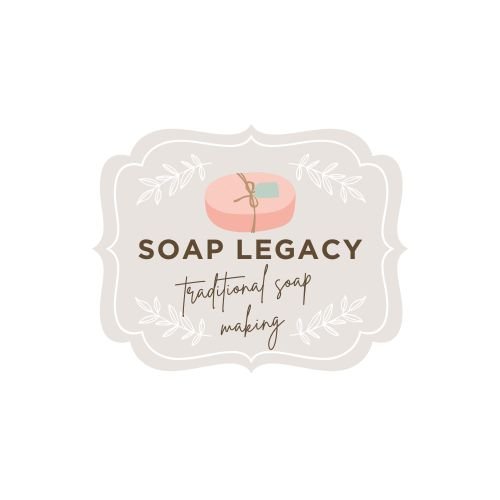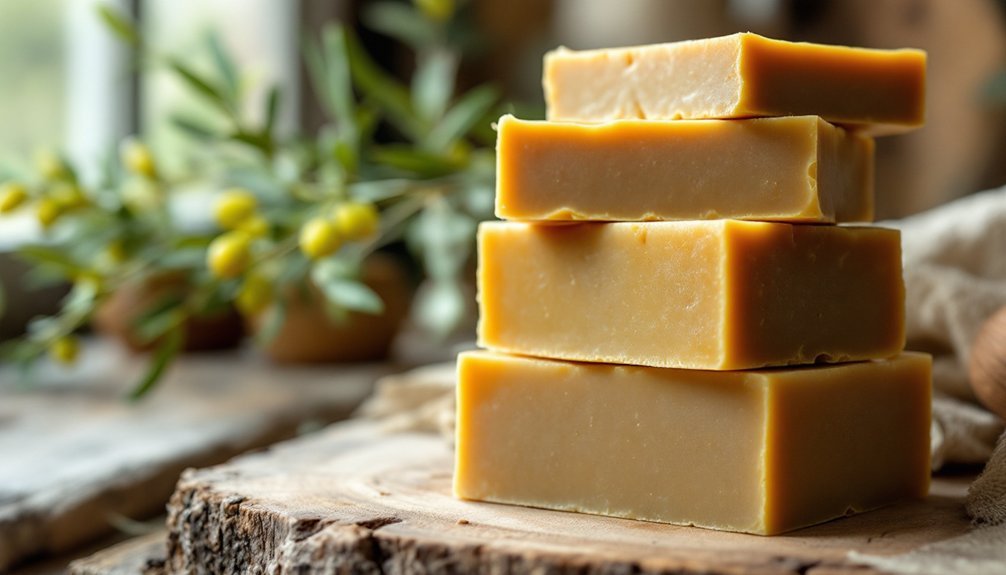Castile soap bars are rectangular due to historical, practical, and scientific reasons. This shape emerged from 18th-century manufacturing processes that enabled efficient production, consistent cutting, and ideal curing. Rectangular bars maximize surface area for proper drying, stack efficiently for storage and shipping, and provide ergonomic benefits with a comfortable grip and stable lathering surface. The traditional shape also preserves the cultural heritage of authentic Castile soap making. Discover why this seemingly simple design choice impacts everything from production to performance.
The Historical Evolution of Soap Bar Shapes

While many bathroom products have evolved dramatically over centuries, the rectangular shape of soap bars has remained remarkably consistent. This design wasn't arbitrary—it emerged from practical necessities in early soap-making traditions.
When you look at 18th-century soap production, you'll find that rectangular molds allowed craftsmen to create uniform bars that were easily stored, transported, and sold. These shapes facilitated efficient cutting from larger soap blocks, maximizing yield and ensuring consistent sizing.
Over time, standardizing the rectangular form became industry practice. The shape proved ideal for stacking on retail shelves and offered consumers a familiar, recognizable product.
This practical design choice transcended mere tradition to become the defining characteristic of soap bars, including the Castile variety you're likely familiar with today.
Efficiency in Manufacturing: Rectangular Molds and Production
When manufacturers design production systems for Castile soap, the rectangular mold emerges as the most efficient choice for several compelling reasons.
You'll find these molds enable uniform cutting and consistent sizing of each bar, maximizing efficiency in production while minimizing waste.
The rectangular shape isn't just practical—it's economical. It optimizes space utilization during manufacturing, storage, and shipping, allowing you to produce more soap in less space.
During the critical production phases, these molds facilitate even cooling and saponification, ensuring your Castile soap achieves the perfect texture and quality.
The design also simplifies pouring and setting stages, reducing spills and waste.
It's no coincidence that traditional soap-makers have favored this practical shape for generations—it simply works better than alternatives.
The Science Behind Curing and Drying Rectangular Bars

The rectangular shape of Castile soap bars maximizes surface area exposure, allowing for more efficient moisture evaporation during the vital curing period.
You'll notice this ideal moisture release contributes to the soap's hardness and longevity, transforming it from a soft, recently poured substance to a firm, long-lasting bar.
The uniform dimensions guarantee a consistent curing pattern throughout the entire bar, eliminating damp spots or uneven drying that could compromise the final product's quality.
Surface Area Maximization
Rectangular soap bars may appear simple in design, but their shape serves an essential scientific purpose in the curing process. When you choose rectangular Castile soap, you're selecting a form that maximizes surface area, allowing faster moisture evaporation during curing. This geometric efficiency isn't just about aesthetics—it's about creating a better product.
| Benefits | Rectangular | Irregular Shapes |
|---|---|---|
| Moisture Loss | Even & controlled | Unpredictable |
| Drying Time | Faster & consistent | Varied & slower |
| Quality | Uniform texture | Potential soft spots |
| Storage | Space-efficient | Wasted space |
The flat surfaces of rectangular bars expose more soap to air circulation, preventing uneven moisture retention that plagues irregularly shaped bars. You'll enjoy better texture and lather quality because the uniform drying creates consistency throughout the entire bar.
Optimal Moisture Release
Because proper curing dramatically affects your soap's quality, understanding the science behind moisture release becomes essential for any Castile soap enthusiast.
The rectangular shape of Castile soap bars isn't just traditional—it's scientifically advantageous for ideal moisture release during the curing process.
The uniform shape of rectangular bars facilitates the evaporation of excess water content in three key ways:
- Maximized Surface Area – Rectangles provide extensive exposure to air, accelerating moisture evaporation.
- Even Airflow – Consistent geometry ensures balanced drying across all sides.
- Monitoring Efficiency – The regular shape allows you to easily track curing progress visually.
When your soap cures properly, it transforms from soft and slimy to hard and long-lasting, with a creamier lather you'll immediately notice when using.
Uniform Curing Pattern
Many soap makers prefer rectangular bars not simply for tradition but for scientifically proven curing advantages. You'll notice that rectangular Castile soap bars cure more evenly because their uniform surface area allows consistent air exposure during the curing process. This shape optimizes air circulation around each bar, reducing moisture content methodically.
| Curing Aspect | Rectangular Advantage | Round Disadvantage | Impact on Quality |
|---|---|---|---|
| Air Exposure | Uniform surface contact | Uneven exposure | Consistent hardness |
| Stacking | Stable, space-efficient | Rolls, less stable | Better air flow |
| Drying Time | Predictable, even | Variable drying rates | Fewer soft spots |
| Moisture Loss | Controlled evaporation | Irregular moisture pockets | Superior final product |
When you stack rectangular bars properly, you create ideal spacing that prevents soft spots and guarantees uniformity in your final product, yielding soap with balanced properties throughout.
Storage and Packaging Benefits of Rectangular Design

The practical design of Castile soap bars offers five key advantages for storage and packaging.
You'll notice how their rectangular shape maximizes storage efficiency in both retail displays and your bathroom, allowing for neat stacking without wasted space. These uniform dimensions guarantee manufacturers can produce consistent bars with predictable weights, making your purchasing decisions simpler.
This shape-driven efficiency extends to packaging as well:
- Rectangular bars fit perfectly into standard boxes, reducing excess packaging materials.
- The flat surfaces create stable stacks that resist toppling during shipping.
- Manufacturers can cut costs by optimizing mold designs that produce multiple bars simultaneously.
When you store your Castile soap bars, you'll appreciate how their space-saving design helps keep your bathroom organized and tidy.
Ergonomics and User Experience of Traditional Soap Shapes
While storage efficiency remains a key benefit, the thoughtful design of Castile soap bars extends directly to your hands-on experience. Rectangular shapes provide ideal ergonomics, fitting comfortably in your palm during washing routines.
| Feature | User Experience | Functionality | Benefit |
|---|---|---|---|
| Flat Surfaces | Stable grip | Prevents slipping | Safer usage |
| Defined Corners | Precision application | Enhanced lathering | Reaches difficult areas |
| Rectangular Shape | Comfortable holding | Easier handling | Reduces hand fatigue |
| Uniform Dimensions | Consistent use experience | Predictable performance | Better value perception |
You'll notice the corners of rectangular bars work perfectly for targeting specific areas like behind ears or underarms. This traditional shape isn't merely about manufacturing convenience—it's deliberately crafted to enhance your cleansing routine, balancing historical soap-making practices with genuine user-centered functionality.
Cultural Significance of Rectangular Castile Soap

Artisans throughout European history have shaped Castile soap into its iconic rectangular form, establishing a cultural touchstone that transcends mere functionality.
When you hold a bar of rectangular Castile soap, you're connecting with centuries of traditional production methods that originated in 18th-century Europe.
The cultural significance of this distinctive shape includes:
- Historical preservation – The rectangular form maintains the artisanal practices of early soap makers
- Brand recognition – The shape has become synonymous with authentic Castile soap products
- Visual storytelling – Each bar silently communicates its heritage and craftsmanship
This geometric uniformity isn't merely practical—it's a deliberate aesthetic choice that honors the historical significance of Castile soap making.
The rectangular shape remains a symbol of enduring traditions that continue to influence modern soap production.
Comparing Alternative Soap Bar Shapes and Their Limitations
You'll find circular soap bars require specialized equipment that can't maintain the same production consistency as rectangular molds, resulting in more manufacturing waste and variable sizing.
The rounded edges of alternative shapes create handling challenges, especially when your hands are wet, unlike the stable grip offered by traditional rectangular Castile bars.
Square bars might seem like a logical alternative, but they don't conform as comfortably to your hand's natural contours and often don't fit standard soap dishes properly.
Circular Shape Challenges
Although circular castile soap bars possess a unique aesthetic appeal, they present several production and practical challenges compared to their rectangular counterparts.
When manufacturers consider soap shapes, the rectangular option consistently proves superior for practical reasons.
Three major challenges with circular soap bars:
- Production complexity – Circular shapes require specialized molds that aren't as readily available as rectangular ones, increasing manufacturing costs.
- Inefficient packaging – Round bars create wasted space during storage and transportation, making them less economical than space-efficient rectangular bars.
- Branding limitations – Circular shapes offer fewer flat surfaces for stamping logos and product information, whereas rectangular bars provide ample space for branding elements.
You'll find rectangular castile bars more user-friendly too, as they fit better in your hand and stay put in shower caddies without slipping away.
Manufacturing Process Limitations
While circular castile soap bars may appeal to some consumers, the manufacturing process heavily favors rectangular shapes due to significant production limitations.
When you compare different soap geometries, you'll find rectangular molds offer unmatched efficiency in production lines – they're easier to fill, empty, and process in large batches.
Rectangular bars provide uniform sizing that's essential for consistent cutting and weighing, ensuring you get the exact product you're paying for.
This standardization also optimizes the curing process, allowing moisture to evaporate evenly from all sides, which improves the soap's quality and longevity.
Alternative shapes create notable challenges: rounded or irregular forms complicate packaging, increase production costs, and generate more waste during cutting.
Manufacturers stick with rectangular designs because they're simply more practical and economical.
Ergonomic Handling Issues
Practical considerations in soap design go beyond manufacturing efficiency to include user experience, particularly in how different shapes affect handling. Rectangular castile bars offer superior ergonomic handling compared to alternative shapes that present distinct limitations.
When you're using soap with wet hands, the rectangular design provides:
- Optimal grip stability – the flat surfaces prevent the bar from slipping out of your hands, unlike rounded shapes that become increasingly difficult to hold.
- Maximum usable surface area – rectangular bars allow you to lather efficiently without awkward angles or unused portions.
- Consistent balance – a rectangular bar sits firmly on surfaces without tipping over, eliminating the frustration of chasing a rounded bar around your sink.
The rectangular form also enables efficient stacking and storage in your bathroom, maximizing space utility while maintaining accessibility.
Sustainability Impact of Traditional Rectangular Soap Bars
Since their inception, traditional rectangular soap bars have offered significant environmental benefits that often go unnoticed. When you purchase a rectangular castile soap bar, you're supporting a design specifically optimized for sustainability. The shape maximizes production efficiency, reducing waste of valuable raw materials through uniform cutting processes.
You'll appreciate how this practical form enhances the environmental footprint throughout the product lifecycle. Rectangular bars stack efficiently during packaging and shipping, allowing more products to fit in less space—directly lowering carbon footprint from transportation. This efficiency extends to storage solutions in manufacturing facilities and retail environments.
The design also promotes even curing, extending shelf life and minimizing product waste. These sustainability advantages make the humble rectangular soap bar an eco-friendly choice despite its seemingly simple design.
Frequently Asked Questions
What Are the Downsides of Castile Soap?
You'll find castile soap can be slimy initially, requires long curing time, creates minimal lather, isn't great for heavy cleaning, and may separate if poorly blended. It's gentler but less effective than coconut oil soaps.
What Do Dermatologists Think of Castile Soap?
Dermatologists generally approve of castile soap because it's gentle, moisturizing, and free of harsh chemicals. They recommend it for sensitive skin and babies, though they'll advise you to patch test for individual sensitivities.
Why Does Castile Soap Go Bad?
Castile soap goes bad when its natural oils break down over time, causing rancidity. You'll notice it's expired if there's an off smell, color change, or slimy texture. Store it properly to extend shelf life.
Why Can't You Mix Castile Soap and Vinegar?
You can't mix Castile soap and vinegar because they neutralize each other. When the acidic vinegar meets the alkaline soap, it causes a chemical reaction that curdles the mixture and destroys the soap's cleaning properties.
In Summary
You've seen how the rectangular shape of Castile soap bars stems from history, manufacturing efficiency, and practical storage benefits. While round or artistic shapes are available today, the traditional rectangle offers ideal curing, less waste, and easier handling. Next time you use that familiar bar, you'll appreciate the centuries of practical design evolution behind its simple, functional form.





Leave a Reply